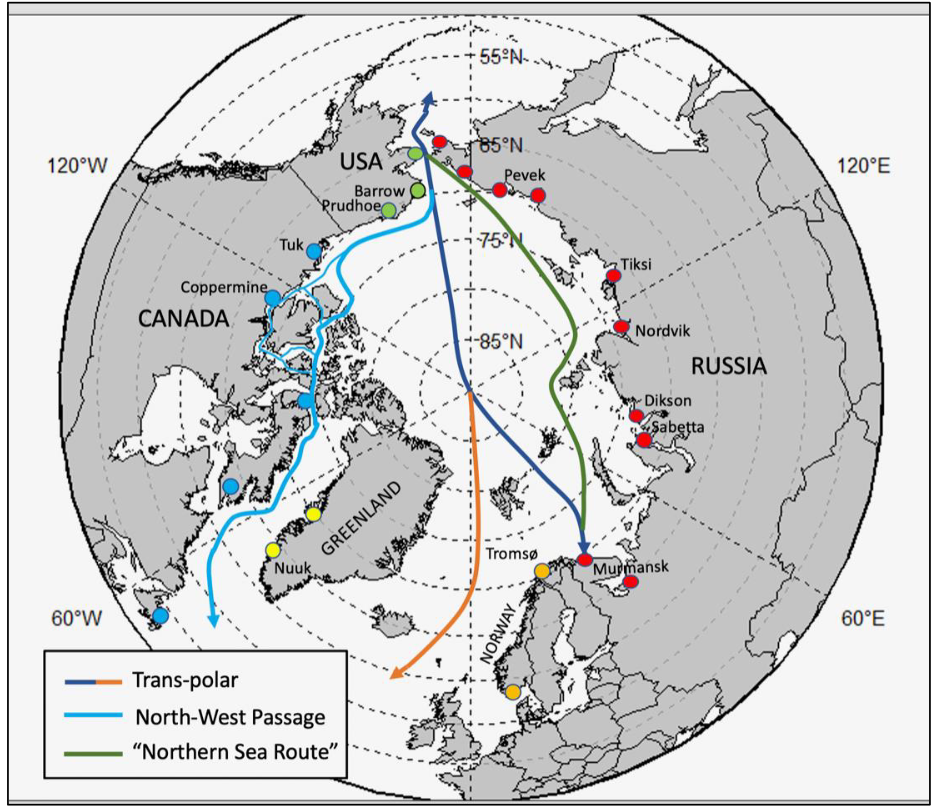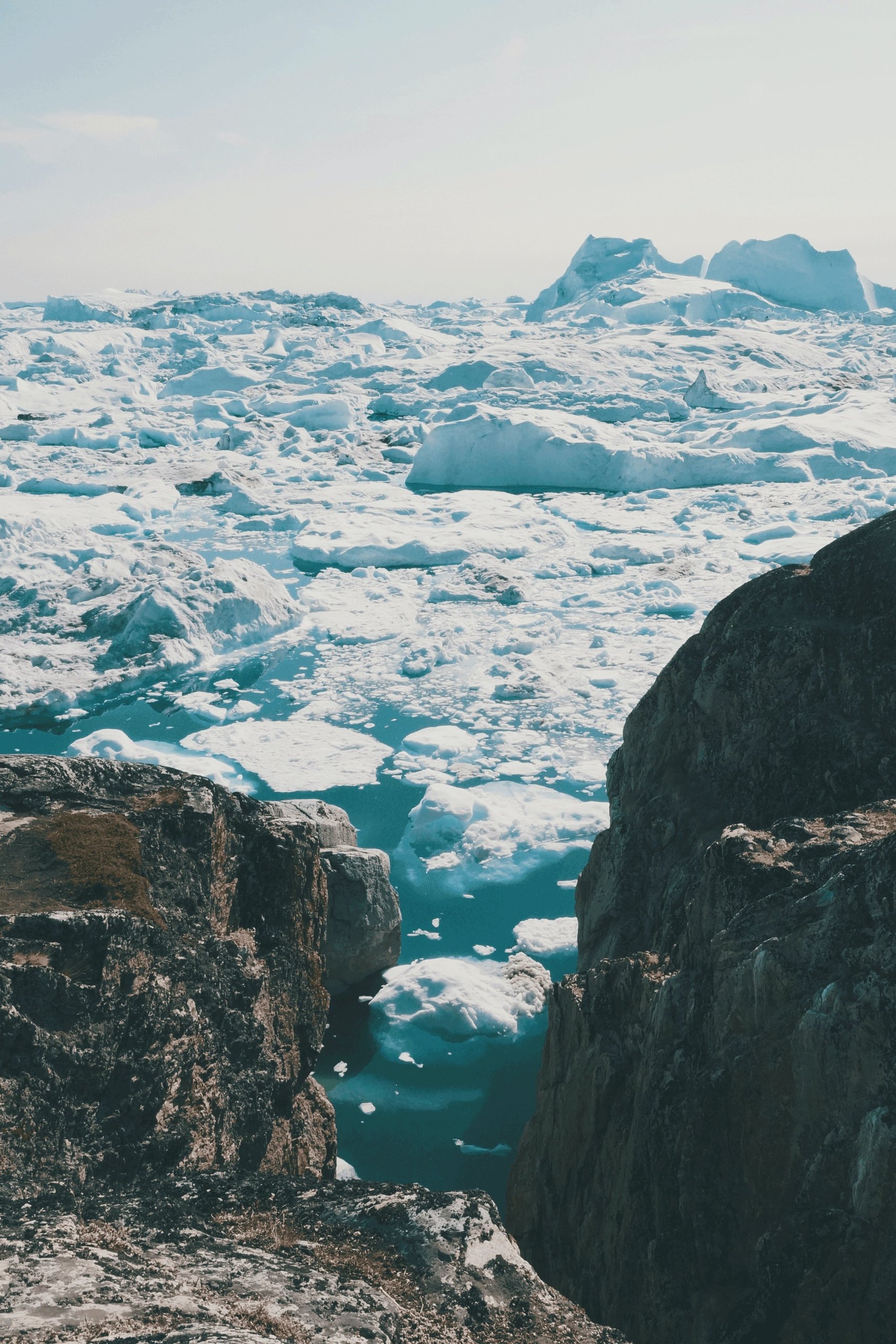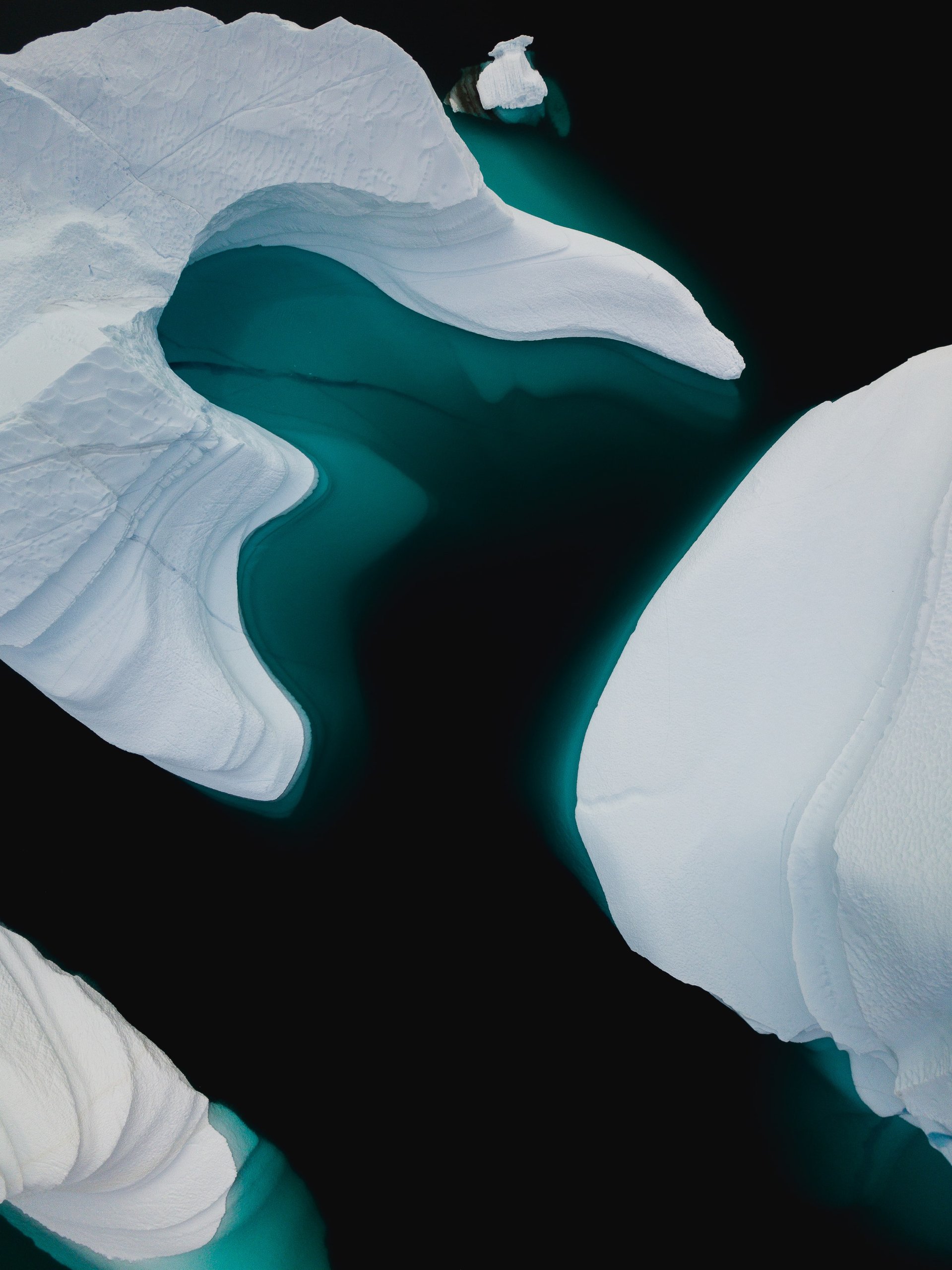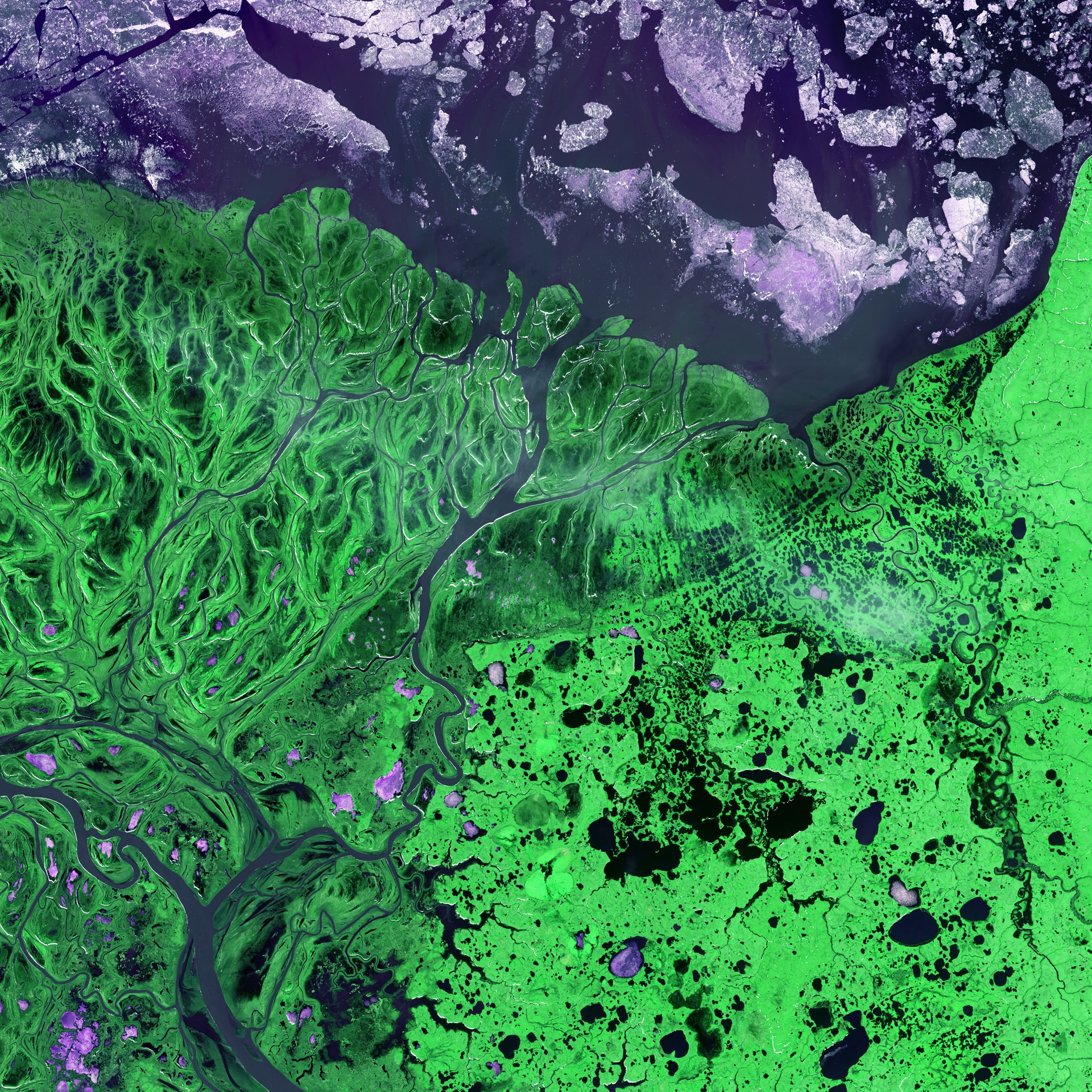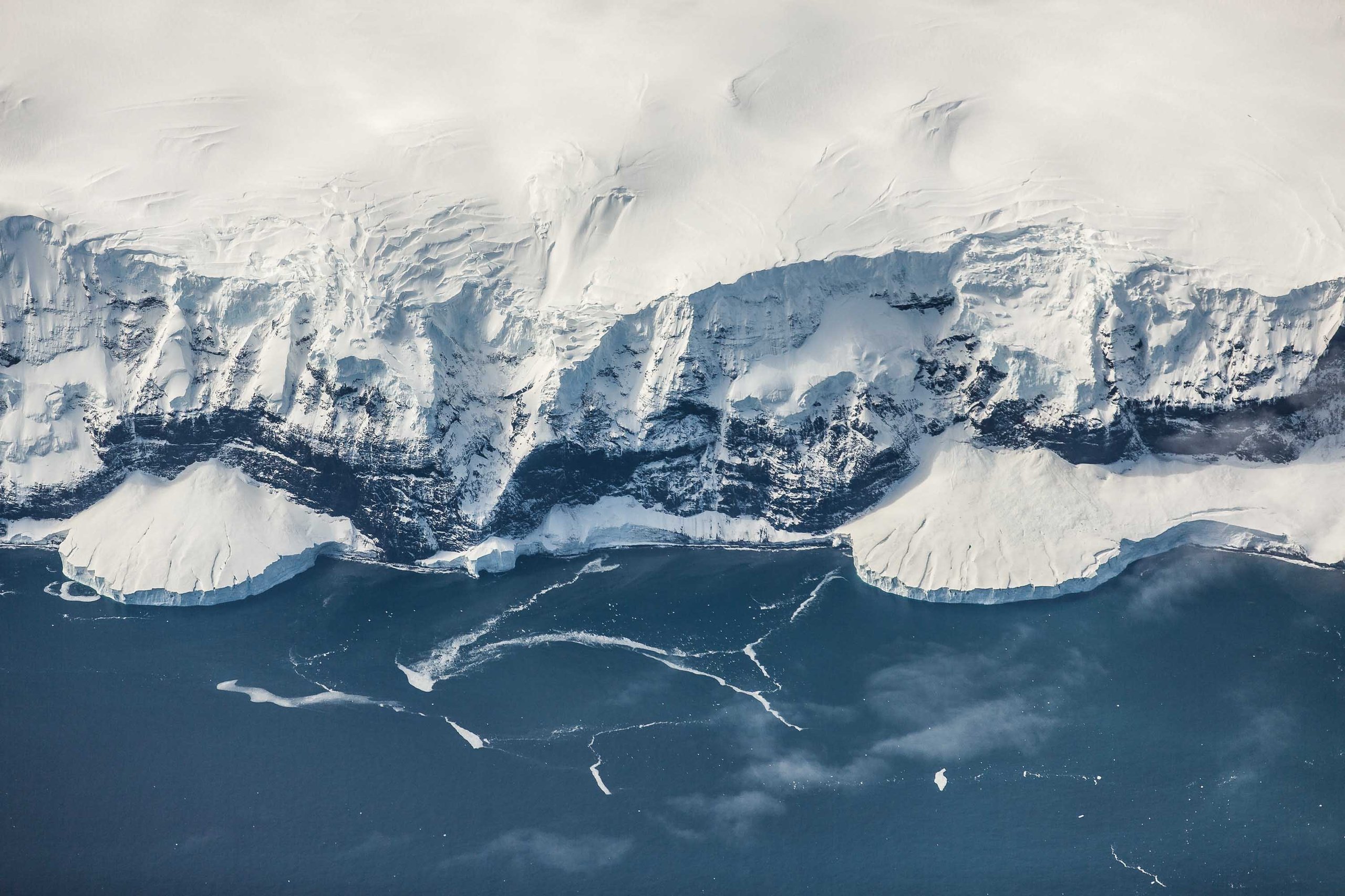Professor David Drewry – January 28, 2021 – 24 min read
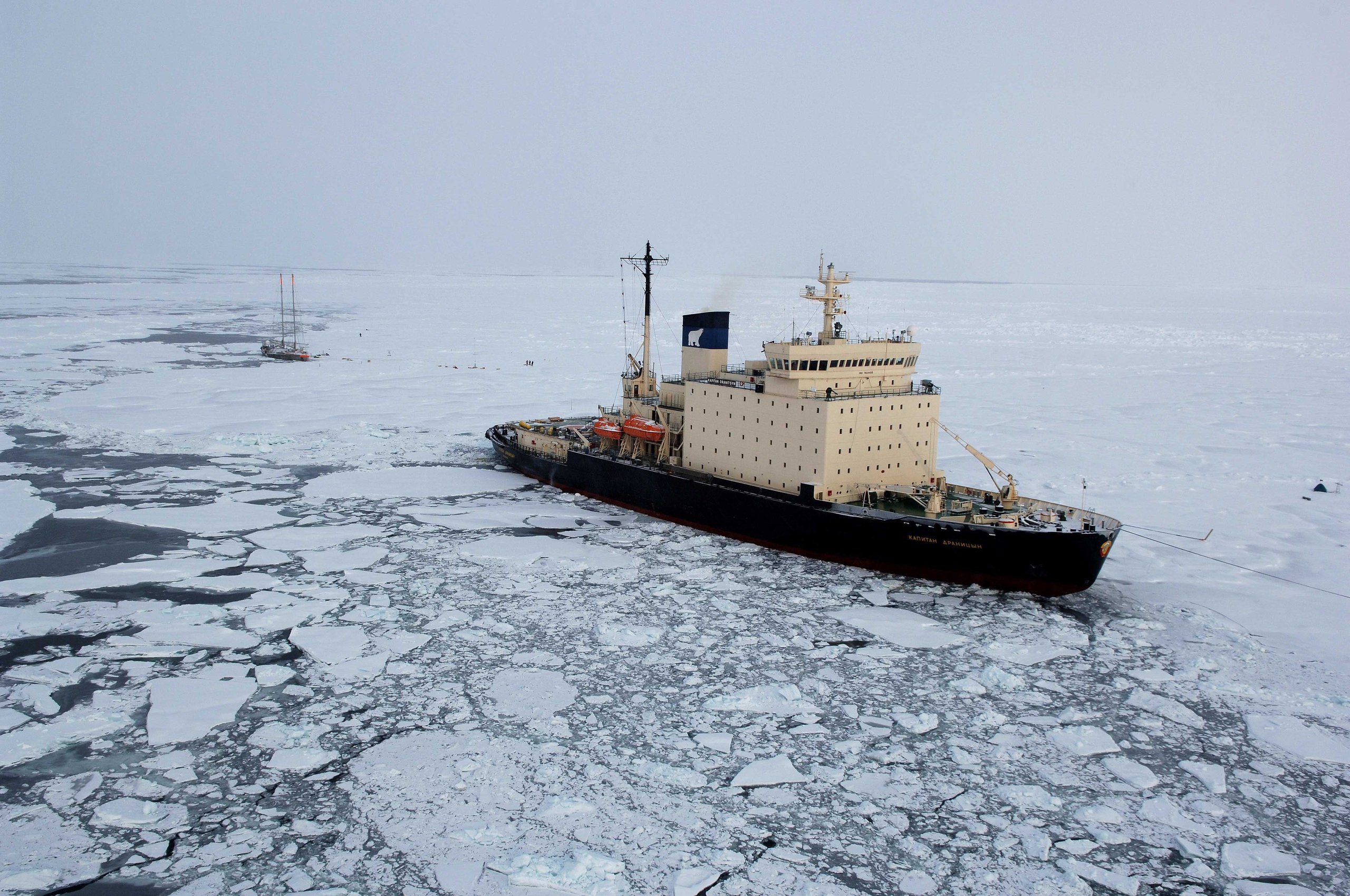
In this blog, Professor David Drewry presents a world in 2075 radically transformed by climate change. The Southern states of the US are uninhaibtable, devestated by heat and drought. Millions of North Americans moved north years ago when the reservoirs and aquifiers ran out and the cost of important water became untenable. David’s scientifically based scenario of the faster, more efficient “Northern Sea Route”, and the huge growth in agriculture, knowledge and technological industries in north regions – the so-called “Cold Rush” – is a subversive warning to us all.
It is 2075 and Yang Hai, the Captain of the Cosco freighter, “Ice Dragon16”, is heading through the Bering Straits on a voyage to Kristiansand in Norway. His vessel is one of over 30 similar ice-strengthened ships the Chinese have constructed in the last ten years to operate in the Arctic along the now busy Northern Sea Route (NSR). “Ice Dragon 16” is not large by modern standards, some 40,000 tonnes, and it is ice-strengthened around the bows. Fifty years ago, this might have made it unusual but today Yang’s freighter plies the seas of the Arctic Ocean for six to seven months of the year. Like its sister ships it has nuclear propulsion. Marine diesel engines were phased out years ago. All new vessels have to demonstrate clean power technology. Russia has been at the forefront of these developments and a clear beneficiary, at least in the early days. This followed the success of their nuclear ice breakers, and as it became clear that the shift to nuclear was inescapable.
The first nuclear units were installed in merchant ships during the early part of the Century, starting with the “Sevmorput”. Russian hegemony, however, lasted only a couple of decades as the Chinese moved quickly to produce their own power plants and now command the largest fleet of such vessels. Many of the Russian icebreakers have been scrapped or laid up as ice conditions only require their capabilities during a few winter months.
Yang takes general container cargo to Europe from the eastern cities of China, principally from Shanghai in the south and Dalian, his home in the north. He loves the ports in southern Norway which are now some of the largest in the world. Parts of Rotterdam were severely damaged a decade previously, as rising seas and brutal storms flooded tracts of adjacent lowland in the Netherlands and compromised that great entrepot.
The Arctic route has cut out at least a third of the journey time from China to Europe making a significant saving in energy as well as turn-around times (see Figure 1). Yang, now in his early 60s recalls how he has witnessed the dramatic opening up of the Northern Sea Route since he was a cadet. Flicking across the screen of his phone he points to a briefing document in the “Arctic Pilot” for the section that explains the progressive reduction in Arctic sea ice since the beginning of the Century. “Look”, he says, “the rot began slowly fifty years ago as the ice pulled back towards the North Pole. We sailors heard about this and the Russians were keen to get us to use their coastal waters in the summer to gain access to Western ports. Of course, in the beginning they charged us a great deal for their navigational and logistics support but even so we made good money. Nowadays, in the summer, we can cut right across the Arctic Ocean, passing by the North Pole and avoid any payments”.
Today the NSR is a very active trading route with almost as much freight as the old Suez Canal sea lane. The Middle East has become a desperate and risky area ravaged by the wars which destroyed infrastructure and cities in the mid-2040s. Severe drought has driven millions out of the region and has hampered the restoration of towns and cities. The United Nations patrols that seaway with a massive presence as it is still a vital link to countries in East Africa and South Asia.
A further significant factor, however, is the regular shut-down of the Panama Canal, often for several months on end. This has forced shipping companies to look elsewhere for freight routes. In Central America, the Gatun Lake lies at the heart of the Panama system providing the huge quantities of water necessary to operate the locks. For several decades, it has been receiving significantly less water from rainfall. The progressive draw-down of the lake has compromised shipping operations. The reduced throughput of vessels and introduction of a quota system combined with steeply rising charges has made this critical pathway between the Oceans increasingly unattractive.
As climate change has disabled the Panama route on the one hand, so it has, on the other, opened up the Northern Sea Route. Russia has, as a consequence, become a major beneficiary of global warming. Even in the 2020s there were clear signs that Siberia would yield an economic dividend as the boundaries of habitability, agriculture and transportation moved north progressively and quickly. “The Northern Sea Route will be the key to the development of the Russian Arctic and the regions of the Far East. By 2025, its traffic will increase tenfold, to 80 million tons” said Vladimir Putin as far back as 2018.
Such positivity and the lucky positioning of significant swaths of the circumpolar north is set against the widespread, profound and long-lasting negative impacts on the natural world and human habitability manifest in social, economic, health and political crises across much of the planet that have escalated during the last fifty years.
“The rot began slowly fifty years ago as the ice pulled back towards the North Pole.”
Canada bides its time
The more tricky, Arctic sea route via the North-West Passage has been something of a frustration for Canadians for some time. While the circuitous system of channels and straits has been used for many years, bad weather, worse ice conditions and navigational hazards have reduced its attractiveness compared with the NSR.
Furthermore, lingering disputes with the USA over territoriality of these waters have been seen as an impediment for some ship operators. The Canadians charge for navigational facilities and emergency ice-breaker support as well as placing an environmental levy on vessels. Although these measures and overall jurisdiction have been challenged by Washington for almost half a century there still has not been a satisfactory resolution to their claim of “international waters”. So far, the low volume of traffic has enabled the Canadians to fend off Washington’s “High Seas” challenges. Inuit and First Nation governments have also complicated dealings with the Americans as their representatives have for some time asserted their independence and important role in any negotiations. It remains unclear how these matters will be resolved.
The enormous volume of traffic from China to western Europe (as well as to the East coast of North America) has been a dominating issue in favouring the NSR. And China has not been simply a passive trader in this regard. It is half a century since Beijing asserted that China was a “near-Arctic state”, much to the incredulity of the circum-polar nations. Flexing its economic and military muscle China instigated and dispatched numerous research expeditions to the Arctic Ocean having built a fleet of high ice-class vessels to support its commercial traffic. These actions and backing from Russia eventually led to the reluctant accession to full membership of the Arctic Council in 2035.
© Daiwei Lu – Photo of the shores of Iceland
Siberian Renaissance: gulag to gismos
China’s and Russia’s domination of the Arctic trading routes has given rise to jointly funded port amenities on the Siberian coast – an extension of the Belt-and-Road initiative instigated several decades earlier with the prosaic title of the “Polar Silk Road”. These facilities have become major outlets for the growing industrial and agricultural activity to the south where clearance of extensive tracts of northern forests has led progressively to massive economic and social change. This is one of the regions that has warmed the fastest and various regional authorities have been swift to take advantage of the improving conditions. New towns and small cities have sprung up where once there was Taiga. Immigrant labour has moved north from central southern Russia where desertification has devastated livelihoods and communities. Many Chinese workers are also here by an agreement to reduce the tensions over the border region of Manchuria. The rivers that once seasonally brought down timber, ‘Ob, Yenisey, and Lena are now waterways serving the NSR with high technology goods and a surprisingly extensive and high volume of foodstuffs, both raw and processed.
Sergei Yanovich is a worker in a bio-engineering facility in Volkhov, some 400km north of Krasnoyarsk. He moved in 2055 as a pioneer and is a laboratory technician. Here, a diversity of new bioactive compounds is being derived from a range of northern plant varieties, many from the West Siberian Plain. Although climate changes have reduced global vegetative species the sub-Arctic and some Arctic regions are providing new and valuable sources for the pharmaceutical industry.
“It is really pioneering work”, he says “in a pioneering environment. The weather here is not so extreme as further east but we have bad mosquitoes in the summer. We are well paid, and our quality of life is pretty good. Our nearest City is Krasnoyarsk, but we now have a rail link there and we can fly to cities in Russia and also to Japan and China.”
The New “Cold Rush”
Rick Burton could not believe his luck. His great grandfather had moved north into Saskatchewan where he had bought acreage along the Churchill River. The land with endless tracts of forest was cheap, but where winters were bone-chilling and the population virtually nil. His 20,000 acres (some 8000 hectares) was a sizeable lot but it was still a hard life, cutting timber, hunting, being more-or less self-sufficient. Two generations of hardship later the wheel has turned. The Government of the Province, in Regina, designated three areas for new settlements concentrating on industrial and high-tech investment and Rick’s was one of these. The huge and relentless shift of population to the north has created new opportunities in the northern prairies. In the early days there were many Americans moving in from southern States cruelly devastated by drought and heat. But this immigration began to overwhelm many small communities and Federal authorities closed the border to US Citizens among others in the 2050s, an unprecedented action more draconian than those taken after the “9/11” bombings in New York and the Covid-19 crisis in 2020. There were many skirmishes and difficult encounters along the 49o parallel until the flow north shifted to Alaska.
In the northern tracts of Russia and Canada, the economies are booming from the effects of the improving climate. Over three decades governments have responded to the new opportunities opened up by the rising temperatures, longer growing seasons, and generally better living conditions. Investment has been encouraged and federal funds used to lever commercial enterprises. The construction industry has benefitted in the first instance with establishment of new road access, airports, and town infrastructure. Thousands of workers were domiciled north to work on these projects, perhaps not dissimilar to the oil and gas heyday in Alaska’s north slope, West Siberian Plain and the Middle East back in the 20th Century. Pipelines have been laid to transport fresh water south from Canada’s myriad lakes to communities into the USA. Many workers stayed after their contracts expired attracted by the widening opportunities the new neighbourhoods offered. Young, eager and talented women and men are settling north escaping from the continuous environmental, political and social problems in the old heartlands of the Americas. The new lifestyle, the clean and spacious surroundings and the opportunities in the knowledge and technological industries have been powerful drivers.
Some have termed the newcomers, who came here mid-Century, the “New Forty-niners” and the whole of the move to the north dubbed the “Cold Rush”.
In stark contrast, there are many abandoned towns in the southern States. But surprisingly they have not lost entirely their commercial value. The political and economic imperative to abandon carbon energy sources and the demand for renewables has opened fresh opportunities. Now dusty, dry and deserted, the endless miles across Texas, New Mexico, Arizona and Southern California have been laid out to solar farms. Improvements in efficiency of solar units and the steeply rising demand for renewable power have changed the landscape dramatically. Now seemingly infinite rows of mega-panels are patrolled by drones and androids. Threatened by fierce and persistent dust storms that scour this arid countryside, their main and unceasing functions are to monitor and maintain these vital facilities.
Some reflections and science
This short, imaginary and highly selective exploration of possible future outcomes of on-going, accelerating and increasingly extreme global climate change has focused on various upside impacts. It is quite clear that there are massive, serious and damaging outcomes of climate change that will be experienced around the planet. Almost overwhelmingly these are portrayed as the only consequences of our carbon culture – flooding, heatwaves, drought, more wildfires, increased storminess and rising seas for example. In no way should a discussion of the positive effects of climate change be seen to diminish the urgent need to reduce drastically atmospheric carbon loading, mitigate the worst impacts of rising temperatures and adapt to a different future. Nevertheless, alterations to our climate present opportunities as much as disasters. Large tracts of our World will embrace warming and the economic and social benefits and exciting potential that it brings. This article is highlighting some of these based on recent scientific analyses by international and regional bodies, which are widely available.
The IPCC analysis should be taken as the most reliable, based on consensus views of large numbers of able scientists. While our scientific understanding of climate change processes constitutes a reasonable first order approximation, we are still refining estimates continuously, incorporating new data, research findings and the unforeseen.
The circum-polar north is one of the regions whose socio-economic development will be assisted by climate change. Already the Northern Sea Route is developing rapidly. There has been progressive reduction of sea ice cover for half a century at a rate of some 12-13% per decade. Ice cover reached new minima in 2012 and 2019. The age of the ice in the Arctic has been diminishing steadily and the thick multi-year, 4-5 years-old ice lying north of Greenland and the Canadian Arctic islands, considered to be the most stable has experienced recent break-up. A number of scientists are forecasting the complete disappearance of sea ice in the Arctic Ocean during the summer by mid-Century. The increasingly rapid reduction is due, in part, to the replacement of highly reflecting “white” sea ice with the darker ocean surface which absorbs much more atmospheric heat, and this creates a positive feedback – a phenomenon first described by Mikhail Budyko in the late 1960s and early 1970s.
Concomitant with the i) loss of sea ice, ii) increase in the area of open water, iii) lower insulating effects of thinner autumn sea ice there has been a significant rise in Arctic land air temperatures. This has also been amplified by the steady and dramatic reduction in snow cover and loss of its similar reflecting and insulating effects. Northern regions of continental North America, Russia and Scandinavia are, as a consequence, warming at a rate two-times the global average. This is revealed clearly in Figure 2 showing the changes in annual temperatures in Canada between 1948 and 2016; in the North the uplift has been 2.3oC. Here the temperatures could rise by 5-6oC towards the end of the Century.
Share this via…


